DOL Releases Guidance on Implementation of AI in the Workplace

The US Department of Labor (DOL) issued guidance concerning the influence of artificial intelligence (AI) in the workplace on federal labor and employment regulations enforced by the Wage and Hour Division (WHD) on April 29, 2024, as reported by ArentFox Schiff Labor.
Delivered as a Field Assistance Bulletin (FAB), the guidance sheds light on the DOL’s perspective regarding AI usage in workplaces and its potential focus areas for enforcement.
It also underscores the importance of human oversight in using AI tools in the workplace.
The opinions expressed in the FAB aren’t formal regulations, however, they provide guidance to DOL field staff enforcing federal laws.
Employers are advised to review their AI tools with legal counsel to ensure compliance with labor and employment laws or make necessary adjustments.
Labor Laws Influenced by the Use AI as per the Guidance:
- Fair Labor Standards Act (FLSA): The guidance highlights potential AI applications like productivity monitoring and schedule management, cautioning employers to oversee these applications to ensure FLSA compliance. Incorrect categorization of time by AI systems that may deem employee time as non-compensable based on productivity or oversight of break times could lead to inadvertent FLSA violations.
- Family and Medical Leave Act (FMLA): Employers utilizing AI for FMLA leave processing should be wary of systematic violations, such as automatic penalties for missed FMLA certification deadlines without considering valid circumstances.
- Providing Urgent Maternal Protections for Nursing Mothers Act (PUMP Act): AI-powered employee tracking may unfairly penalize nursing mothers utilizing break time for expressing breast milk, which violates PUMP Act provisions that entitle them to adequate break periods and suitable accommodations for such activities.
- Employee Polygraph Protection Act (EPPA): EPPA typically forbids private employers from conducting lie detector tests on employees. Specific AI technologies capable of monitoring employee eye movements, voice patterns, and other bodily cues to detect deception could also breach the EPPA, contingent upon how they are employed.
- Surveillance and Protected Activity: AI programs may be used for surveillance, and actions resulting from such surveillance might break federal laws against retaliation in the workplace. For example, using software to predict the chances of a certain area unionizing based on employee feedback could deter such activity and be considered illegal retaliation.
Employer Liability:
- One significant aspect of the DOL’s guidance is its stance on employer liability regarding the use of AI systems or tools.
- Even if these systems are developed by third-party software developers, employers may still be held accountable for any unlawful actions of these AI tools.
- Merely claiming ignorance of the AI system’s operations won’t serve as a defense against liability.
- Hence, it’s crucial for employers to grasp the functioning of such tools, including the criteria the tools use in tasks like resume screening or employee performance evaluation, and to establish appropriate procedural measures to ensure that AI-influenced decisions adhere to lawful and transparent standards.



